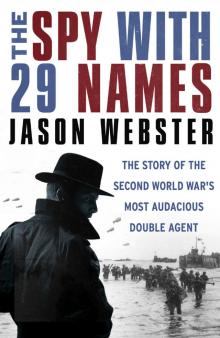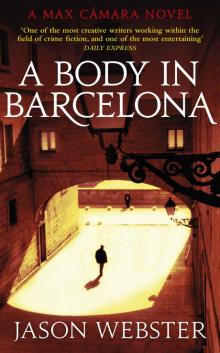- Home
- Jason Webster
The Spy with 29 Names Page 2
The Spy with 29 Names Read online
Page 2
At home, in Spain, he was known as Juan.
In the secret worlds in which he moved, he went under many different names . . .
Bletchley Park, December 1941
The ‘Cottages’ were a line of three small adjacent buildings near the main house. They had served as the head coachman’s quarters before the war, but now housed Dillwyn Knox’s team of code-breakers – mostly pretty young women like Mavis Lever. People called them ‘Dilly’s Girls’.
Knox was one of Bletchley’s ‘characters’, eccentric intellectuals working at the Government Code and Cypher School (GC&CS), trying to crack encrypted German wireless messages. They were the lifeblood of the place.
A classicist from Cambridge, Knox was often likened to a character from a Lewis Carroll novel, long and lean and, as one friend put it, with a ‘face like a pang of hunger’. Now in his late fifties, he would sometimes wander around Bletchley in his dressing gown, not realising that he had not put his clothes on that morning, frequently losing his glasses or his tobacco tin under piles of decrypted messages. In one absent-minded moment he mistakenly stuffed bread from a sandwich into his pipe.
Mavis, still only nineteen at the time, felt a strong connection to Knox, seeing in him echoes of Alice’s White Knight: ‘endearingly eccentric and concerned about my welfare’.
‘We’re breaking machines,’ he had said to her the day she first arrived in the Cottages, in 1940. ‘Have you got a pencil?’
The respect and affection were mutual and the young recruit soon became the elder code-breaker’s protégée. Mavis had broken off her German studies at London University to get the job, and if Knox started quoting Milton’s Lycidas to her she would respond with something appropriate, perhaps from Heinrich Heine’s poetry. There was an affinity between them; years later she would write his biography.
Bletchley Park was like a small town by this point in the war, with thousands of people working intensely on the enemy’s codes, many of them in the huts that had been quickly assembled in the grounds. It got cold in winter. The Cottages were sturdier structures, better for keeping the heat in. Mavis was lucky.
The work was hard and there were rolling shifts throughout the day and night. A canteen was provided in the main house, but sometimes there was little more to eat at three in the morning than a handful of overcooked Brussels sprouts. There was a community spirit, however: when not code-breaking, Mavis enjoyed the concerts, the amateur dramatics group, and the Scottish country dancing.
Knox spent little time with them in the Cottage that December, he was seriously ill and was busy fighting a battle with Bletchley’s operational head Alistair Denniston over how their decoded material was handled within the intelligence services. Mavis’s work was built around Knox’s methods, however, and the thinking required for solving the puzzles created by the enemy’s Enigma machines.
‘Which way do the hands on a clock go round?’ he would ask.
‘Clockwise.’
‘That depends on whether you’re the clock or the observer.’
They had already enjoyed one great success together, breaking the Italian naval codes earlier in the year. This had played a vital role in the Battle of Matapan in the spring, when the Italian Navy suffered a major defeat at the hands of the British. Churchill described it as the greatest sea triumph since Trafalgar.
‘Tell Dilly we have had a great victory in the Mediterranean,’ Admiral Godfrey rang through to Bletchley. ‘And it’s entirely due to him and his girls.’
As a reward, Knox had taken Mavis out to dinner, driving in his Baby Austin to the Fountain Inn at nearby Stony Stratford, and arranged for her to get a raise on the 35 shillings a week she was then earning.
That was in April 1941. Now it was December, yet as Mavis and her colleague Margaret Rock worked to piece together a new puzzle, it was clear that something just as important – more so, even – was happening.
After months of effort, carrying on from Knox’s first hammer blow against the cipher in October, on 8 December Mavis and Margaret finally cracked the code used by German intelligence and were able to look at their first deciphered Abwehr message. If the Allies could listen in on what Germany’s spies were saying to each other, then the enemy would have few secrets left indeed.
Knox was delighted.
‘Give me a Lever and Rock,’ he said, ‘and I can move the universe’.
It was a great achievement, one which vindicated his unusual methods – using linguists and even a speech therapist to help him break ‘mathematical’ codes. Yet despite insisting that the credit be given to his ‘girls’, the ‘rodding’ system that they were using to break the German encryption was his making, and henceforth the decrypted messages would bear his name – even after, just over a year on, he died of lymph cancer.
Around them, the war carried on. The morning after her breakthrough, Mavis heard of the Japanese attack on Pearl Harbor. It seemed clear that the Americans would be joining them soon. Meanwhile, to the east, the Red Army was finally starting to push the Germans back from the outskirts of Moscow. It was not obvious at the time, but these events, taken in conjunction with her own success of the day before, meant that those few days in early December would prove to be a pivotal moment in the conflict.
After reading the first coded message, they had much more work to do. Mavis and Margaret were ‘in’, but it would take weeks before a proper stream of Abwehr messages could be produced. Out of a team of seventeen ‘girls’ they were the only ones with any German: more linguists would be needed. It was Christmas Day 1941 before this new, important source of information could be passed on to the rest of British intelligence, a service which, at the beginning at least, involved decoding anything between fifty and a hundred Abwehr telegrams a day. Later that figure would be multiplied several times over and a total number of 140,000 messages were read by the end of the war.
Mavis was on her own that day – Knox was ill and had to stay at home, where Margaret was taking him material to carry on their work. There were no celebrations. All the same, it was a significant moment. ‘On Christmas Day 1941 the geniuses at Bletchley broke the Abwehr Enigma . . .’ Hugh Trevor-Roper wrote. ‘When that was done we really were in a new age.’
British intelligence officers could now read what their German opponents were saying to each other almost as easily as they read the morning newspapers. It was not Mavis’s job to analyse the messages that she and her colleagues cracked, however. That was the work of the intelligence officers at MI6 – of which GC&CS was a part – busy absorbing the material with which Mavis and Knox were now providing them.
In the German texts that they were reading, however, one curious name appeared, mentioned in the disturbing traffic between Abwehr headquarters at 76/78 Tirpitzufer in Berlin and its Madrid spy station. These were references to the ‘Arabalfn1 undertaking’, a mysterious Nazi spy ring operating from inside Britain itself, headed by an agent called ‘Alaric’.
The thought caused a shudder. A phobia about enemy spies was gripping the country. There were rumours of jackbooted nuns parachuting into Warwickshire, signals ploughed into remote fields for German spotter planes, and chalk symbols on telegraph poles. One elderly lady had even concluded that her neighbour was sending messages to the enemy through a form of Morse code based on the long and short garments on her washing line. It was hard to know who to trust.
They were less excitable at Bletchley. Nonetheless, over the following weeks and months Mavis and her colleagues were to come across many more references to the sinister ‘Alaric’.
The question was, who was he?
St Albans, January 1942
Desmond Bristow spent most of his day checking hotel registers sent over by agents in Madrid and Lisbon. His job was to look for anyone suspicious – a name that did not tally, or that had cropped up somewhere before. Still, he told himself, it beat being an infantryman. Back in May 1940, while waiting for a train at Oxford station, he had caught sight of badly wounded
soldiers returning from Dunkirk: that had rid him of any ideas about fighting on the front line.
He had not imagined that being a spy would be quite so dull, though. Betty was pregnant, and he missed her. Worcester was a long way from St Albans. At least he had his beloved Matchless motorbike and could use spare petrol coupons to drive over to see her occasionally. But apart from the odd pint at the King Harry pub with his boss, there was little to break the tedium.
After two and a half years of war there were plenty of reasons to be spying abroad, which was what MI6 – the Secret Intelligence Service – concentrated on. But there were no foreign postings for Bristow. Not even in Spain, where he had been brought up. Yes, they valued his knowledge of the language and the culture and that was why he had been taken on. But he had been placed in Section V of MI6, the branch that dealt with counter-espionage, and Section V had moved out of London to Glenalmond, an Edwardian red-brick town house in the sleepy town of St Albans.
He was still only twenty-six, too young to enjoy drinking pink gins with the others after work in the conservatory. The ‘snakepit’, they called it.
At least there was Philby.
His boss had a bit of a stutter, but knew and loved Spain as Desmond did, having been The Times’s correspondent there during the Civil War. Older than Bristow by about five years, he was easy to talk to. Before long they became friends and Bristow would take him around St Albans on the back of the motorbike, heading out to the pub after work. Kim Philby made life in Glenalmond that bit more bearable.
Colonel Felix Cowgill was part of the problem. Formerly of the Indian Police, the head of Section V treated Glenalmond like a medieval castle. He was a suspicious man and had fallen out with most of the other chiefs in the intelligence services. His department’s role was to work through counter-intelligence reports from foreign countries – information about attempts to spy on Britain – and, where necessary, pass them on, not least to the other major counter-intelligence organisation, MI5, the Security Service. Where Section V of MI6 dealt with ‘abroad’, MI5 handled Britain and the Empire, with a large degree of overlap between the two. This should, in many people’s minds, have led to high levels of cooperation. But Cowgill thought otherwise: he suspected MI5 wanted to take over his territory. Citing a need to protect MI6 sources, he only allowed a portion of his material to be passed on.
Philby hated him.
‘Lack of imagination, inattention to detail and sheer ignorance of the world we were fighting in . . .’ he wrote. ‘Glenalmond . . . felt like a hedgehog position; Cowgill revelled in his isolation.’ What was the point of receiving so much intelligence if they were not going to share it? Now that the Abwehr codes had been properly cracked, Cowgill was becoming more difficult than ever. Philby had to resort to passing information on to friends in MI5 verbally, informally, ‘to avoid needless trouble’.
Decrypted German messages were referred to as ISOS, standing for ‘Illicit Services Oliver Strachey’, after the GC&CS man in charge of breaking Abwehr messages that had been enciphered by hand. ISOS had been online since April 1940, before Bristow had joined. More importantly, though, the new German messages coming through had been enciphered not by hand, but using Enigma machines. These messages were far more complex and useful than previous ones, and had only recently been broken by the GC&CS team headed by Dilly Knox. They had started arriving properly on Christmas Day 1941, and were officially referred to as ISK – ‘Illicit Services Knox’. Like many people, however, Bristow did not differentiate between the two, and ended up referring to all the deciphered Abwehr material as ISOS.
The messages were biked over by special courier to Glenalmond in the morning, arriving at 10.30. It was foggy and icy the day that they first heard of ‘Arabal’. Bristow had just lit the fire and Philby was sitting by the bay window wearing a scarred leather jacket he had picked up during the Civil War in Spain. Tim Milne, one of their colleagues, read through the intercepts dealing with the Iberian Peninsula.
‘This sounds very odd,’ he said, staring at one of them.
Bristow looked up from his hotel registers. From the window, Philby glanced over.
‘What does it say?’
Milne handed it to him. Bristow walked across and looked over his shoulder. He saw a typed message written in capital letters, and there, in front of them, was the text from the Abwehr’s station in Madrid to headquarters, telling their Berlin masters about a new Vertrauungsmann – a ‘trusted man’, or spy – reporting from London. This agent, this V-mann code-named ‘Alaric’ by the Germans, was being run by the Abwehr station in Madrid. What was worse, as Bristow and Philby read on it appeared that this new enemy spy was not alone. Alaric claimed to have recruited three sub-agents to work with him: ‘Senhor Carvalho’, a Portuguese travelling salesman based in Newport, south Wales, where he spied on shipping movements in the Channel; ‘Herr Gerbers’, a German-Swiss businessman based in Bootle, near Liverpool, spying on the Mersey; and a wealthy Venezuelan student based in Glasgow.
The Germans were referring to this spy network as ‘the Arabal undertaking’.
‘Alaric’? ‘Arabal’? None of them had seen the names before. Yet here, on the decrypted Abwehr message in front of them, this new Nazi spy was reporting the formation of a shipping convoy in the bay of Caernarfon, clearly with a view to alerting German U-boats for an attack. What should Section V do?
Philby wasted no time. He picked up the green scrambler phone to warn their colleagues at MI5: the spy was on home turf and the Security Service needed to be informed.
Bristow, like everyone else in the office, stopped what he was doing and listened in on the conversation. This was by far the most interesting thing that had happened since his arrival at Glenalmond. Philby got through to Herbert Hart, the head of MI5’s research department. Bristow noticed how Philby clicked his fingers while he spoke, trying to control his stammering.
‘Have you seen his message from M-M-Madrid on the Caernarfon convoy, Hart?’
It appeared that MI5 had also seen the Arabal message, and were equally worried and perplexed.
‘Get Scotland Yard on to it,’ Philby said.
The spies had a lead, but the police were the best people to start a physical search for any German agents. Meanwhile, MI5 would talk to their liaison officer at the Admiralty about the Caernarfon convoy.
‘We’ll go on watching and see what comes of it. Bye for now.’
Philby put down the phone, and the office became a buzz of conjecture.
Who was this new enemy agent?
‘Surely he must be a Spanish sailor off one of those merchant ships tied up in Liverpool?’ Jack Ivens, another member of the team said.
‘Why should he or she be a Spaniard?’ Bristow replied, playing with a cigarette. ‘He could be a Dutchman or woman, Swedish national or whatever.’
They all looked at each other. None of them had any idea.
‘I wonder what means of communication our mysterious Arabal used?’ Bristow asked.
Philby shook his head.
‘We must not get c-c-carried away on a guessing game,’ he said. ‘It wastes time, and if this character is important there will be another reference from ISOS soon enough.’
Bristow and the others took the hint: they went back to their work, wondering in silence.
The following communications only deepened the mystery.
First was a written report sent through from Commander Ewen Montagu, MI5’s liaison officer with the Admiralty, who had been asked about the reported Caernarfon convoy. To their surprise, Montagu told them categorically that no such convoy existed.
A few days later, Scotland Yard’s Special Branch also reported back. After a thorough search, no trace of an enemy agent had been found.
There was, it seemed, no German spy, and no Caernarfon convoy, yet the following week Alaric and the Arabal network were mentioned once again by the Abwehr in the Bletchley intercepts, the Madrid station telling Berlin that according to their m
an, ‘CONVOY SAILED FOUR DAYS AGO IN SOUTHERLY DIRECTION.’
Philby became exasperated when he saw it.
‘What’s going on? We know there is no bloody convoy.’
He looked at Bristow.
‘Who is Arabal? Why is he so obviously lying?’
London, 22 February 1942
Major Thomas Argyll Robertson, head of MI5’s B1A section, was a busy man. For ten days Luis Calvo, Spanish journalist and member of a pro-Nazi spy ring operating under orders from Madrid, had been locked up in MI5’s interrogation centre, Camp 020 on Ham Common. Within twenty-four hours the Spaniard had confessed. Stripped naked, he only had to catch sight of camp commander ‘Tin-eye’ Stephens cracking his swagger stick against his riding boots to break down.
There was cleaning up to do, however, after the public exposure of a Spanish reporter with close ties to the embassy. Staff there were anxious to avoid an escalation of the crisis. After this, other countries would take a second look at the Spanish diplomats on their territory.
Nonetheless, it had been a success for MI5: simple counter-espionage, stopping the enemy’s intelligence operations in their tracks. Not that Spain was officially an enemy, but she was certainly no friend.
The case might not have involved Robertson (he was always called Tommy, or ‘Tar’, after his initials) had it not been for the fact that one of his double agents had played a part in exposing Calvo. Gwilym Williams was known by his initials, G.W., the only one in the double-cross pack not to have a proper code name of his own. ‘Snow’, ‘Tricycle’, ‘Tate’ – the others were all part of Robertson’s special club; once they had been taken into the fold, either willingly or not, all were re-baptised. But not G.W.
MI5 had got G.W. in to keep a watch on Arthur Owens – double agent ‘Snow’ – the shifty Welsh nationalist who thought he could play one side off against the other. That was not how double-cross worked, however. To be on Robertson’s team, agents worked exclusively for him, only ever pretending to be working for the Germans. It was a simple and necessary rule. The whole structure, all the double agents they had painfully built up since the beginning of the war, would collapse if the enemy got an inkling that one of ‘their’ agents had been turned and was working for the British.

 Violencia
Violencia Or the Bull Kills You
Or the Bull Kills You The Killing of El Niño Jesús
The Killing of El Niño Jesús The Spy with 29 Names
The Spy with 29 Names Duende
Duende Guerra
Guerra Sacred Sierra
Sacred Sierra A Body in Barcelona: Max Cámara 5
A Body in Barcelona: Max Cámara 5 Fatal Sunset
Fatal Sunset A Death in Valencia
A Death in Valencia Blood Med
Blood Med Andalus
Andalus